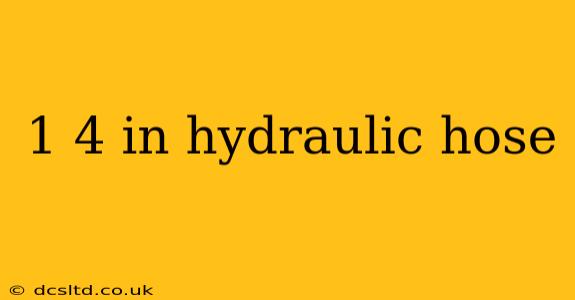Hydraulic hoses are the lifeblood of countless industrial and mobile equipment applications, silently powering everything from construction machinery to agricultural implements. Understanding the specifications of these critical components is crucial for safety, efficiency, and longevity. This guide focuses specifically on 1/4" hydraulic hoses, explaining their applications, specifications, and considerations for selection and maintenance.
What Does 1/4" in a Hydraulic Hose Refer To?
The "1/4"" in "1/4" hydraulic hose refers to the inside diameter (ID) of the hose. This is a crucial measurement, as it dictates the hose's flow capacity. A larger ID allows for a greater volume of hydraulic fluid to pass through per unit time. It's important to note that the outside diameter (OD) of the hose will be larger than 1/4" due to the hose's wall thickness.
What are the Typical Applications of a 1/4" Hydraulic Hose?
1/4" hydraulic hoses, due to their smaller size, are generally used in applications requiring lower flow rates. They are commonly found in:
- Low-pressure hydraulic systems: These hoses are suitable for systems not requiring high pressures.
- Smaller equipment: Think portable power tools, smaller agricultural equipment, and some types of industrial machinery.
- Instrumentation and control systems: Precision applications where controlled fluid flow is paramount often utilize smaller diameter hoses.
- Auxiliary circuits: In larger machinery, 1/4" hoses might be used for auxiliary functions, such as control circuits or lubrication systems.
What are the Different Types of 1/4" Hydraulic Hose?
The type of 1/4" hydraulic hose needed depends heavily on the specific application's pressure, temperature, and fluid compatibility requirements. Common materials include:
- Rubber: Offers good flexibility and cost-effectiveness, but has limitations in terms of temperature and pressure resistance.
- Thermoplastic: Provides better resistance to chemicals and abrasion than rubber, along with temperature tolerance. Specific types of thermoplastic will have differing characteristics.
- Wire-reinforced: Provides additional strength and pressure resistance compared to unreinforced hoses.
How Do I Choose the Right 1/4" Hydraulic Hose?
Selecting the correct 1/4" hydraulic hose requires careful consideration of several factors:
- Working pressure: Ensure the hose's rated working pressure exceeds the maximum system pressure.
- Fluid compatibility: The hose must be compatible with the hydraulic fluid used in the system. Incompatibility can lead to hose failure and system damage.
- Temperature range: The hose needs to withstand the operating temperature of the system.
- Hose length and routing: Consider the length required and any bends or obstacles the hose needs to navigate. Sharp bends can weaken the hose and compromise its longevity.
What are the Safety Considerations When Using 1/4" Hydraulic Hoses?
Hydraulic hoses operate under pressure, posing potential safety hazards. Always:
- Inspect hoses regularly: Look for signs of wear, such as cracks, bulges, or leaks. Replace damaged hoses immediately.
- Use proper fittings: Improperly installed fittings can lead to leaks and failures.
- Avoid kinking or crushing the hoses: This can weaken the hose and create stress points.
- Use appropriate personal protective equipment (PPE): Eye protection is especially crucial when working with hydraulic systems.
How Often Should I Replace My 1/4" Hydraulic Hoses?
There's no single answer to how often you should replace your 1/4" hydraulic hoses. Regular inspection is key. Replace hoses exhibiting any signs of wear or damage. Factors such as operating conditions, fluid type, and the hose's material will affect its lifespan. Consult the manufacturer's specifications for guidance.
What are the Common Problems with 1/4" Hydraulic Hoses?
Common problems include:
- Leaks: Often caused by damaged hoses, loose fittings, or wear and tear.
- Blisters or bulges: Indicate internal damage and potential failure.
- Cracks or abrasions: Weaken the hose and lead to leaks or ruptures.
This comprehensive guide offers a solid foundation for understanding and utilizing 1/4" hydraulic hoses effectively and safely. Remember, always prioritize safety and consult with a hydraulic specialist when in doubt.
